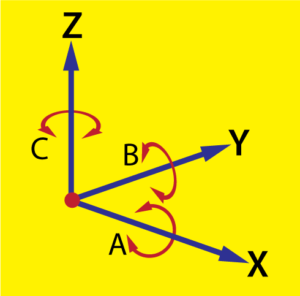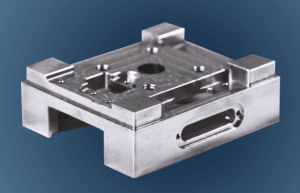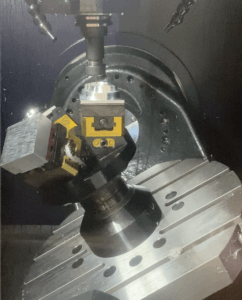Do More with Less with 5-Axis Machining
It doesn’t take long after you put your first 5-axis machine into production to realize that you can do more with less, and wish you had done it sooner. While the initial cost of investing in 5-axis machining and programming software may seem daunting and out of reach, it’s important to look at the bigger picture. Some good hard number crunching on your current 3-axis machine performance is an absolute necessity. You’ll need to determine the cost of multiple setups to finish a part, cost of fixturing, cost of scrap and labor, wasted time in re-orienting parts and the lost quality due to having to move the part around multiple times. Sure, the maintenance on a 5-axis machine is a little more cumbersome, but in the end, 5-axis machining will help you remain competitive allowing you to expand your markets and take advantage of new opportunities. And, you can expect a quicker ROI due to reduced setup, less part handling, less errors and scrap, shorter cycle times.
What is 5-Axis Machining?
 True 5-axis machining is also known as 5-axis machining or 5-sided machining. Like the name implies, these 5-axis machines actually have the ability to operate in five axes – three common linear – X, Y and Z, and two rotational – A and B along with the rotary table that rotates around the Z-axis, defined as the C-axis. With these five axes, there is almost unlimited possibilities in the type and shape of parts that can be machined. 5-sided machining uses the “done-in-one” approach, effectively eliminating the need for secondary machining and enabling the machining of intricate complex parts.
True 5-axis machining is also known as 5-axis machining or 5-sided machining. Like the name implies, these 5-axis machines actually have the ability to operate in five axes – three common linear – X, Y and Z, and two rotational – A and B along with the rotary table that rotates around the Z-axis, defined as the C-axis. With these five axes, there is almost unlimited possibilities in the type and shape of parts that can be machined. 5-sided machining uses the “done-in-one” approach, effectively eliminating the need for secondary machining and enabling the machining of intricate complex parts.
Industries and processes that can benefit from 5-axis machining include, but not limited to, automotive, aircraft structural parts, military, highly precise and complex medical devices, energy, firearms, die mold, prototype manufacturing and more. What was once impossible to make on one machine or a single setup, is now a possibility with 5-axis.
How is 5-Axis CNC Machining Different Than 3-Axis CNC Machining?
A 3-axis machine, the most common type of CNC machine, moves the tool in three linear axes – X, Y and Z. They are easy to program and operate and are a perfect low-cost option for simple geometry parts. However, with only three axes, these machines have limitations. For instance, simple, complex workpieces, or parts requiring a quality surface finish, might require multiple setups or need to be repositioned and clamped into custom-made fixtures, in order to get all features completed, making them more susceptible to errors and economically unfeasible.
With 5-axis technology, you can easily machine all sides of a simple or complex part in a single setup on one machine. Without having multiple setups or reorientation of the tool as is the case on a 3-axis machine, a part can be machined faster with less chance of errors.
Why Should I Invest in a 5-Axis Machine?
Maybe you have all the business you can handle, or you’re satisfied with the status quo, and resolve that “if it ain’t, broke don’t fix it”. There’s nothing wrong with that. But let’s face it, if you’re in business, you want to make the most of it.
The logical assumption is that you’re in business for the long haul. So, if your machine shop is spending more time on setups than on machining, or you’re having trouble increasing production times to meet customer requirements, or if you’re trying to bridge the skills gap, it may be time to consider 5-axis machining.
While you can survive these drawbacks, not investing in 5-axis could prevent your machine shop from new business opportunities not only within your marketplace, but in more lucrative parts manufacturing industries.
Take the medical device industry, for instance. Small medical device parts are intricate in nature and usually require more intensive milling and finishing. While this can be performed on a 3-axis machine, the time for additional setup for the milling and surfacing might be cost prohibitive, and more handling increases the chance for error, possibly resulting in lost opportunity.
Or, what about rapid prototyping? You don’t do that because of the multiple setups on a 3-axis? Well, now with a 5-axis workhorse on your floor, you can provide your customers with prototypes quickly.
Another area for improvement is in the use of the highly reliable hole making process – interpolated holes – which can be refined on a 5-axis. This would eliminate the need to use a tooling hole for component alignment prior to boring as it would be on a 3-axis.
Maybe you’re going through tools on your 3-axis like a hot knife goes through butter. Five-axis’ ability to tilt the tool or table to maintain an optimal cutting position and consistent chip load as well as the fact that 5-axis reduces cycle times, leads to extended tool life.
Maybe you don’t think you have room for a 5-axis. Think again. One 5-axis machine can do the work of several 3-axis machines. Think of the floor space saved for other technologies, or for more 5-axis machines.
As lead times become more critical and as jobs become more complex in their geometries and multi-sided parts, awkward angles, intricate features, and complexities, having a 5-axis machine could be your new best friend.
Benefits of 5-axis Machining
 While 5-axis machines may seem like they are better suited for complex machining or complicated parts, 5-axis machines will also make short work of your everyday run-of-the-mill basic workpieces. The justification for a five-axis machine on these grounds alone, are enough to make the change. Five-sided machines truly are suitable for general and specialty jobs alike. Here are a few reasons to consider 5-axis machining.
While 5-axis machines may seem like they are better suited for complex machining or complicated parts, 5-axis machines will also make short work of your everyday run-of-the-mill basic workpieces. The justification for a five-axis machine on these grounds alone, are enough to make the change. Five-sided machines truly are suitable for general and specialty jobs alike. Here are a few reasons to consider 5-axis machining.
1. Single Setup Machining
Reduced setups for simple and complex parts alike increase not only your production time but increase the quality of your parts significantly. With the done-in-one approach, you save time and money and get better utilization of all your production equipment. It’s not uncommon to go from five setups to one with 5-axis.
2. Less Fixturing or Inexpensive Simple Fixturing
By eliminating secondary setups, the requirement for special fixturing may be reduced or eliminated all-together. Less setups, mean less fixture prep, which reduces the need for additional machines or manpower.
3. Machine More Complex Shapes
With more angles to position the workpiece and therefore more access to it, 5-axis machining allows unique tool path operations and the ability to machine more complex shapes with a great degree of accuracy.
4. Shorter Cutting Tools Can be Used
With 5-axis machining, you can use shorter tools because now with 5 axes, you can tip the tool away from the workpiece. This produces higher cutting speeds and less tool vibrations, better surface finishing and less tool deflection.
5. Better Surface Finish
With less vibration due to shorter tools , there will be a better surface finish. Also, since 5-axis machines have a rotating table or spindle, more consistent cuts can be made for a smoother surface.
6. Quicker Material Removal
With 5-axis machining, the cutting tool is perpendicular to the cutting surface and therefore can more easily remove more material per pass, resulting in lower cycle times and therefore faster removal of material.
7. Reduced Labor Cost per Part
Reducing setups and fixturing, means that one machinist might be able to run a machine with limited attention, and/or run multiple machines at one time.
8. Shorter Lead Times
Less setups mean producing a part in a fraction of the time. And less time means more money. In fact, you may even be able to do quick turnarounds on short-run parts, and maybe even get into prototype work as a result.
9. Higher Part Accuracy
You can expect higher part accuracy due to the part not needing to be moved for setups or moved across multiple machines.
10. Improved Floor Space
One 5-axis machine can replace several 3-axis machines, saving floor space.
11. Increased Cost Savings and Faster ROI
Improved tool life, less errors and therefore less scrap, less fixturing and setups and reduced floor space needs. And with more machining flexibility, 5-axis machining is money in your pocket and a faster rate of return on your 5-axis machining investment.
12. Expanded Opportunities in More Markets
If you’re not machining 5-axis parts, then your competitor is, and most likely getting bids that your shop is not equipped for. Besides giving you a technological advantage, a 5-axis will open up doors to compete for more contracts in more markets. With 5-axis you can make nearly anything in less time, less operations and at a lower cost per part.
Debunking the Most Common 5-axis Machining Myths
Too Expensive
It is true that 5-axis machines are more expensive. You get what you pay for though. For one, to ensure high precision and accuracy, these machine tools are solidly built to withstand forces created by the cutting process and continuous movement of the axes. In addition, they are equipped with highly responsive servo drives to enable the machine to respond to thousands of commands simultaneously, they include high accuracy rotary tables to precisely position the workpiece, and they necessitate high processing power to process data fast enough, to name a few. The value of these benefits by far outweigh its cost, as they will enable your shop to more cost-efficiently produce a wider range of work.
Hard to Program
Unfortunately, old 5-axis machines of yesteryear have given 5-axis machines of today a bad rap. The modern 5-axis machines of today often include easy-to-use programming software, and if you need something more robust, the most popular CAM software programs have bridged that gap.
More Collisions
While the motion of multiple axes does increase the incidence of collision, most 5-axis machines come with or can be fitted with collision avoidance software which simulates the cutting process prior to running the machine. Not only does this control crashes, but it can also help reduce setup times.
Not Accurate
In fact, the opposite is true. With reduced setups, a 5-axis machine has become more accurate than a 3-axis that requires multiple secondary setups which ultimately increases the likelihood of error.
Need Highly Skilled Operators to Program
As 5-axis is more complex, there is no doubt that more skilled operators are required. There needs to be a good understanding of machine motion, good 3D visualization skills, the ability to create appropriate tool paths and more extensive knowledge of CAM software. Of note, while having a skilled machinist will help you maximize the capabilities of 5-axis, the control and software of the machine is equally important. And, with good training from a reputable and knowledgeable machine tool partner such as Productivity, this obstacle is easily overcome.
Master the Art of 5-Axis Machining with Productivity
While 5-axis machining may seem daunting, it is a great way to differentiate your shop from your competitors, and it will pay back huge dividends. With 5-axis machining you’ll produce parts more efficiently, faster and with higher accuracy, increase the range of work you can do, and open up areas of production that you didn’t even consider possible. With the done-in-one approach, your machine operators can spend more time managing additional machines. You can count on 5-axis to reap benefits for years to come.
If this information has piqued your interest in and appeased some of your fears of 5-axis machining, then we can help get you on the right path to 5-sided machining. At Productivity, we understand that moving to five-axis machining is a big investment. We’ll work with you to assess your manufacturing operations, and with multiple lines of high quality 5-axis machines, we’ll match the correct machine to your application. All this supported by applications and service staff who are highly skilled in 5-axis technology. We’ll make sure you get the right machine, and get it into production quickly, with strong support and machine training. Check out our lines of 5-axis machines – Haas, Matsuura MX, MAM72 and CUBLEX Series, Makino Vertical and Horizontal 5-axis, Hwacheon.
We have a great archived webinar entitled “Maximizing Your 5-Axis Machine – Part 1: Considerations to Meet Expectations” that will give the info you need to get your facility ready for 5-axis Machining. Sign up here to watch this pre-recorded webinar.




